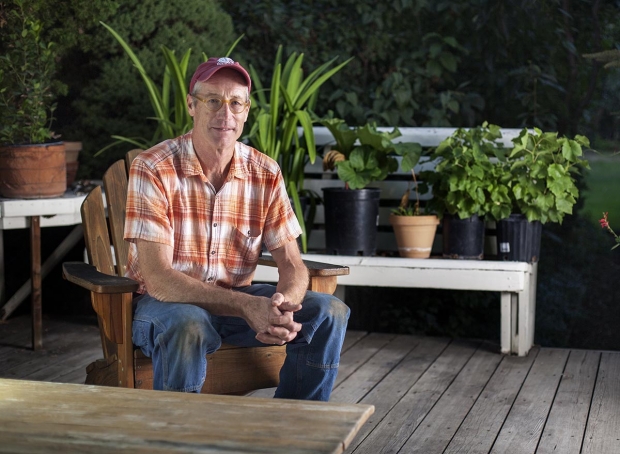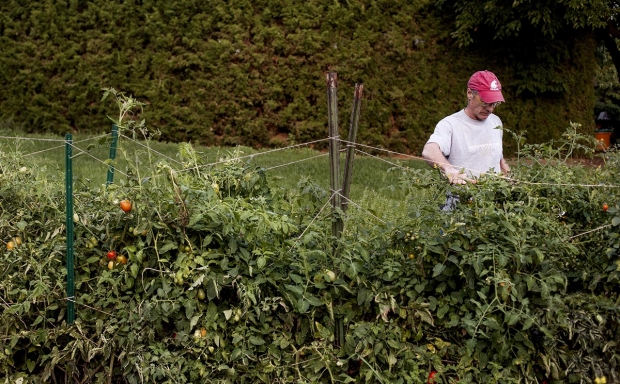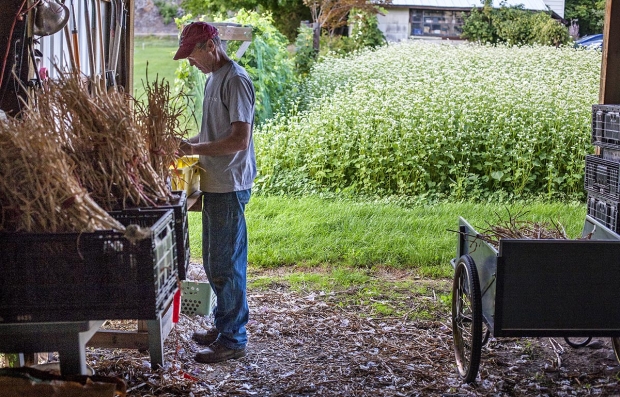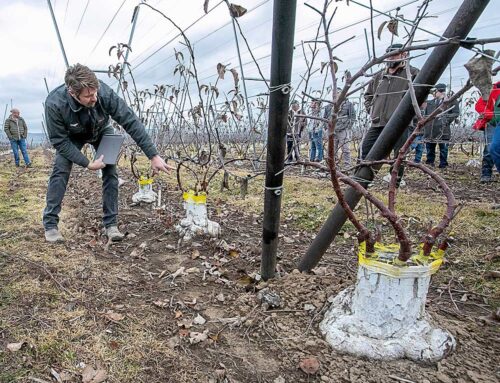
Jim McFerson, manager of the Washington Tree Fruit Research Commission, at his home near Wenatchee, Wash., on Sept. 16, 2013. (TJ Mullinax/Good Fruit Grower)
McFerson is manager of the Washington Tree Fruit Research Commission, which allocates more than $4 million annually in research funds and receives requests for far more than that.
Researchers hoping for a piece of the funding submit proposals—short summaries of their project goals. The commission prefers to fund projects that match their research priorities, involve teams of multidisciplinary scientists, and have an extension component—so that growers can quickly benefit from the results.
The element most often lacking in proposals is an economic analysis to show the potential costs and benefits, McFerson said.
Researchers with the most promising proposals are invited to discuss their projects in more detail before an audience of research commissioners, advisory committee members, and industry representatives.
In discussions managed by McFerson, woe betide the researcher who does not define his or her project well, does not have an extension component, shows slides with text in ten-point type or too many tables that the audience can’t read, or otherwise performs poorly.
The nine commissioners are growers, not scientists, and as the industry’s production problems become more complex and the science more difficult, it is harder to find industry members willing to sit through a day or a day and a half of technical presentations, McFerson says.
“It’s particularly hard when researchers aren’t concerned about connecting with the audience and give us presentations that are difficult to understand and evaluate,” he said. “I think there’s too much bullshit collegiality that goes on.”
Uncaring

Jim McFerson tends his large garden looking for cherry tomatoes for dinner at his home outside of Wenatchee, Wash., on Sept. 16, 2013. (TJ Mullinax/Good Fruit Grower)
McFerson doesn’t vote on which proposals get funded, but it is his job to communicate the funding decisions. “Unfortunately, as the manager of the commission and messenger of bad news to researchers who don’t get funded, I’m often seen as an uncaring and difficult person to work with,” he said.
“I believe that my reputation would be seen as hard nosed and brusque, and aggressive—which is probably fair enough. Researchers get wrapped up in their world and their life and, understandably, when they’re rejected for an application for funding it hurts.
It means you can’t do what you want to do in your program. Some people take it better than others. But if you’re not given constructive criticism you aren’t going to improve because you think everything’s okay. There’s a balance between making the person feel bullied or underachieving and challenging them to do a better job.”
Less funding
McFerson said he enjoys working with good scientists and wants them to succeed. He recognizes that with less funding coming from both state and federal sources, scientists are suffering excruciating budget constraints.
The assessment that growers pay to the commission for research is based on tonnage ($1 a ton for apples and pears and stone fruits, $4 a ton for cherries) so the total funding available will increase along with production, though slower than the need for funding as the commission receives more and more requests for larger and larger projects.
Growers recently voted to pay a “special project assessment” equal to their regular assessment that will raise $32 million over an eight-year period for research at Washington State University.
Already, WSU has begun using the funds to hire two world-renowned scientists, Dr. Desmond Layne, as tree fruit extension team leader, and Dr. Stefano Musacchi as research pomologist, both based in Wenatchee.
The university is also in the process of hiring a plant physiologist and a pathologist. With the addition of these new faculty, the commission expects to receive even more funding requests.
Good writing

Jim McFerson cleans garlic bulbs recently dried from his garden outside of Wenatchee, Wash., on Sept. 16, 2013. (TJ Mullinax/Good Fruit Grower)
Applicants should know that McFerson appreciates good, precise writing. “Especially for technical writing, to me, there’s a premium on clarity and brevity, and the same thing is true of a research proposal,” he said.
McFerson, 62, is a skilled writer and avid reader who, after a day engrossed in the scientific realm, might go home and enjoy reading political analyses or pick up a biography of Elvis Presley, whom he always admired. “I love language and I enjoy its expressiveness, but I’m not a particularly poetic person,” he said, revealing that he was a writer for his high-school and college newspapers and enjoyed investigative reporting.
He and his three brothers grew up in Iowa and Wisconsin. All his grandparents were farmers and his father, Bob, was a fertilizer salesman. He left school in 1971 and did a number of unpleasant jobs, including loading fertilizer onto railroad boxcars and working at a funeral home. After deciding to continue his education at the University of Wisconsin-Madison, he kept the funeral home job to help pay expenses.
As a bonus, he got a free room in the back of the building, but when anyone departed at night, he’d have to go out with the mortician to pick up the body. “It didn’t help my social life much,” he reflected.
He was undecided whether to major in agricultural journalism or horticulture, but after getting a work-study job in a college greenhouse and being hired by his advisor Dr. Fred Bliss to work with the plant-breeding program, his mind was made up.
He earned a bachelor’s degree in horticulture, then went to Texas A & M University to study for a master’s in horticulture. He returned to UW-Madison to obtain a doctorate in plant breeding and genetics.
Ill-defined

Jim McFerson, manager of the Washington Tree Fruit Research Commission, at his home near Wenatchee, Wash., on Sept. 16, 2013. (TJ Mullinax/Good Fruit Grower)
For the next five years, he worked as a vegetable breeder for a private company, and then headed the U.S. Department of Agriculture’s Plant Genetic Resources Unit in Geneva, New York.
In 1997, he was approached by George Ing, then manager of Washington’s Research Commission, and commissioner Doyle Fleming, who said they were looking for a scientist to work for the commission on field horticulture research and help with strategic planning in preparation for Ing’s retirement.
The commission had launched its internal research program in 1993, when it hired plant pathologist Dr. Peter Sanderson to work areas that were not being covered by university or USDA scientists.
Ing’s rationale was that it would be cheaper and more effective for the commission to do its own research without all the “bureaucratic folderol” of having to work with WSU administrators, McFerson recalled.
The university administration at the time was perceived to be far less friendly and supportive of production agriculture and specialty crops than it is today. McFerson, his wife, Carol, and two young daughters, Maureen and KC, then lived in a lakeside farmhouse in Geneva, not far from his parents.
He liked his work, felt he was in a good situation, and had no plans to leave, but was intrigued by the unsolicited and unexpected opportunity to go to Washington, as ill-defined as it seemed.
The challenge of working more directly with agriculture—and specifically a dynamic industry that values research and is willing to change—appealed to him. So the McFersons bought an old farmhouse in Wenatchee with enough land for him to plant a garden with his favorite crops, garlic and hops.
At the commission, he launched research projects in apple and stone fruit horticulture and crop load management. He was appointed manager in 2001, when Ing retired, and made it a priority to forge more productive and effective partnerships with other research entities, such as the land-grant universities, the USDA, and private companies.
“Resources were diminishing, and we could not afford not to create partnerships,” he recalled. “We had missed opportunities.” In terms of the commission’s internal research, he saw a need for more research with a practical focus conducted in grower cooperators’ orchards throughout the state. Gradually, the number of staff increased to 10, supplemented by 6 to 10 interns, depending on the time of year.
Fortunate
Dr. Ines Hanrahan, who joined the commission as project manager in 2005, said some people are wary of McFerson but she feels fortunate to have him as a boss. He allows her the latitude to conduct her own research and the flexibility to work around her family commitments.
“I feel that’s very progressive and it’s has enabled me to excel,” she said. “People ask, ‘How do you deal with him?’ If you do your work and do a good job, it’s just fine. He has high expectations, and you’d better not disappoint him, but it’s not personal. It’s just getting the best out of everybody.”
Jim Doornink, chair of the commission and a board member since 1985, said McFerson’s expectation level may be high but he understands what people are capable of accomplishing.
“It’s based on the experiences that he’s had in his research life and his administrative life,” he said. “He’s been a researcher, he’s been a USDA administrator, and he’s been with the tree fruit industry, where he’s done both.”
Doornink said it’s like working with a team of horses. If you have experience, you know how much they can pull. Without it, you don’t know whether to whip them harder or apologize because the load’s too heavy.
Genetics
McFerson worked with key industry people to develop the Tree Fruit Technology Roadmap to guide future research and worked at the national level to secure funding.
Money became available through the USDA’s competitive Specialty Crop Research Initiative to help address the roadmap’s objective, which was to help growers deliver fruit of the highest quality more efficiently and consistently.
“I think our crop production and protection practices, from the nursery all the way through to handling, have benefited from the research we have supported and made the industry aware of,” he added, stressing that it all begins with genetics. “You can never do better than the genetic potential of your crop.”
Doornink said that, with his background in genetics, McFerson has been able to guide the commission’s efforts specifically to where genetics can help the industry both in the short and long term.
Over the years, the commission has provided millions of dollars to WSU’s apple and cherry breeding programs, in collaboration with the Oregon Sweet Cherry Commission, to aid in the discovery of improved cultivars.
“Products from both those programs are going to provide our growers with genetics that are going to be more productive, more attractive, and more profitable than any we have ever had,” McFerson said. “We’ve got material better than anything available in the market right now.” •






Leave A Comment